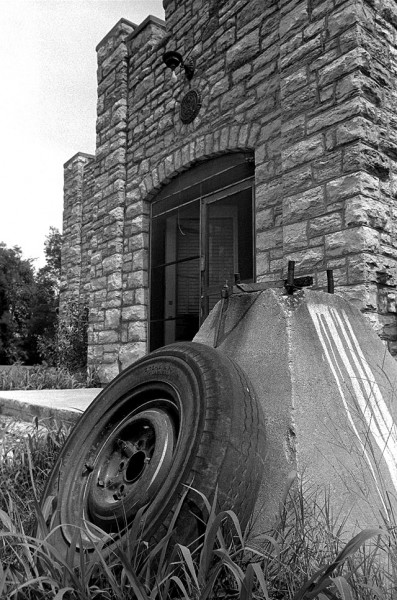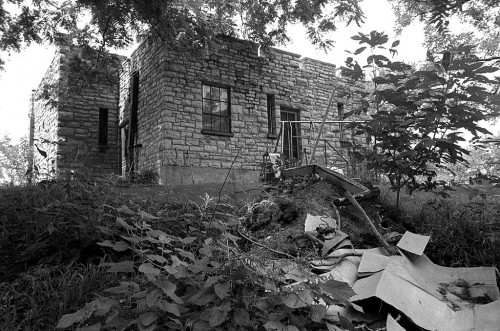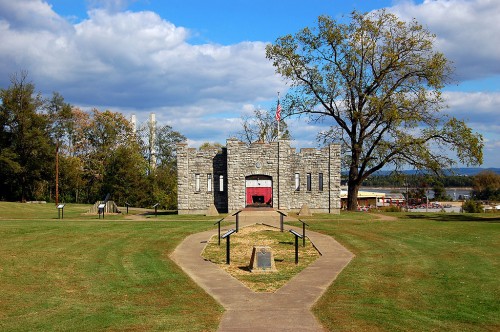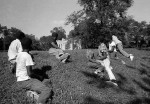 I’m pretty sure the photo with the tire ran in The Missourian, but a quick Google Archives search for 1966 didn’t pop up the story.
I’m pretty sure the photo with the tire ran in The Missourian, but a quick Google Archives search for 1966 didn’t pop up the story.
The stories that DID show up that year included one where some out-of-town tourists wondered why Fort D didn’t have any historical markers telling its story.
How long has that thing been missing?
“Darn!” said the City Fathers. “There used to be one up there. Wonder how long it’s been gone?”
The city had a caretaker living in the Fort for awhile, but when he moved out, all of the windows were broken out. (In a story that may or may not have been related, a caretaker was arrested for drunken driving and may have had other housing assigned to him.)
Weeds and trash
 Weeds and trash were allowed to grow up around the landmark.
Weeds and trash were allowed to grow up around the landmark.
Fort D tourist-worthy in 2008
 When Brother Mark and I rode up to Fort D on our bikes in October 2008, the grounds were well-kept and there were plenty of interesting historical markers to make the trip worthwhile.
When Brother Mark and I rode up to Fort D on our bikes in October 2008, the grounds were well-kept and there were plenty of interesting historical markers to make the trip worthwhile.
The building is missing its roof, unfortunately.
I wrote about the history of the Fort on my bike blog. in 2008. Follow the link to read more about the fort and to see more contemporary photos.
I was disappointed to find that this isn’t the original fort. The American Legion bought the site to save it from development in 1936, and the WPA built the building in 1937.
Fort D Photo Gallery
Here are more photos from 1966. Click on any image to make it larger, then click on the left or right side of the photo to move through the gallery.









If one does a google search for For D Cape Girardeau you can click on the Fort D site and see the history of Fort D.
Ttpographical error. Should be Fort D Cape Girardeau.
Hey, another error. Typographical.
Hal,
There are some days when you should quit while you’re ahead. Here are some examples of newspaper corrections (that may or may not be true):
“Our newspaper carried the notice last week that Mr. Oscar Hoffnagle is a defective on the police force. This was a typographical error. Mr. Hoffnagle is, of course, a detective on the police farce.”
“IMPORTANT NOTICE: If you are one of hundreds of parachuting enthusiasts who bought our Easy Sky Diving book, please make the following correction: on page 8, line 7, the words ‘State zip code’ should have read ‘Pull rip cord.'”
Cape Girardeau sits on the first continuous high ground in Missouri upstream of the Ohio River and was deemed an important site for numerous strategic reasons. Fort D was constructed in 1861 by Union troops at the same time as the other Cape Girardeau forts. It is the only remaining one of four Civil War forts that protected the City of Cape Girardeau from Confederate attack. Like the others, Fort D was designed by Captains Franz Kappner and Henry Fladd of the Army Engineers. Construction began on August 6, 1861, under the direction of Lieutenant John W. Powell from Illinois. The design is in a French bastion form, a triangle with open base. The earthworks faced away from the river. Reportedly, Fort D housed both 24 and 32-pound cannons, which would easily control any upriver movement on the Mississippi. Soldiers who served at the fort reported that “Quaker” cannons (logs painted black) were used to enhance the appearance of the armament. In order to keep warm during the winters, soldiers dug artificial caves in the hillside below the fort and stayed in these. In 1936, the site was purchased by the American Legion post, and the earthworks were restored to their original height, with some modifications. A stone building, constructed in the middle of the fort at the site of the original powder-house, was dedicated to the city and today is part of the City of Cape Girardeau Parks & Recreation Department. Fort D did not see action during the Battle of Cape Girardeau and probably never fired it guns in anger, serving mostly as a symbolic deterrent. The earthwork walls remain intact and historical signage throughout the fort’s grounds bring its storied past to life. Fort D is located at Fort Street and Locust Street in Cape Girardeau. The fort is open daily from dawn to dusk
I as dating my wife of 47 year when she and her family lived at Fort D. They moved there in 1962 and remained until 1966. Much work was required to make the building suitable for a family residence. My father-in-law was talented in all areas of construction and began building interior walls
and designig and building the kitchen and bath. With the help of the family the work was completed and they went into the maintenance mode. The home was always well kept and clean. I can atest to that having been there many times. The Cape Park Commission had the responsibility of maintaining the grounds and did an excellent job during the time the family lived there. I can only assume that after the family moved the park commission stopped and the weed and vandales along with others who think it is to far to the city dump took over.
One last question…What does a traffic volation have to do with this story?
What does a traffic violation have to do with the story?
Relatively little.
About as much as an obit for a black iceman had to do with Walther’s Furniture Store and Funeral Home. Or, the memories of a former slave in a piece about May Greene School. Cape’s history isn’t something that’s neatly wrapped in a bow. It’s bunches of intertwined tales.
The traffic violation on Page 3 in The Missourian was one of only five stories that came up in the Google News Archives when I searched for Fort D and 1966.
I didn’t mention the person’s name, nor did I publish a link to the story (although it’s not hard to find) because I didn’t want to draw direct attention to any one individual for something that happened nearly half a century ago. (Although I don’t have a whole lot of sympathy for someone who allegedly blew .27 in the good old days when .15 was the legal limit.)
It was relevant because it mentioned that the city had someone living there, something I wasn’t aware of. It also mentioned that the person who was arrested was facing a year of jail time for driving with a revoked license and for DWI.
If, indeed, the person was sent away (and I couldn’t find a disposition this morning), then it might have caused the building to become vacant and vandalized.
Thanks for letting us know more about Fort D. The last time I was there, in 2008, the building was nothing but a shell with no roof.
There was a story April 6, 1963, about a surprise 14th birthday party being held in the fort. I wonder if your wife attended?
I took piano lessons from a Mrs. Schultz that used to live at Fort D when I was in Washington grade school. V. West
Back in the 1940s, one year, Brownie Scouts had Day Camp at Fort D. It was quite comfortable, for summer in Missouri, sitting out under the Fort’s big trees doing our Cum-Ba-Ya thing. The old site was well kept, but hardly a tourist attraction. Other years we met in the baseball stands at Capaha Park.
The building in the fort is not only not original, no such building existed in the original fort at all. Within the walls there was a command tent and a powder bunker. The bunker was dug in the ground, roofed over with timbers, and covered with dirt. Fires would have been prohibited anywhere near that. The fort is a redan, which is a French military term. A redan is a two-sided earthworks; at Fort D these sides are intact. The rear, towards the river, had a palisade wall of unknown height. Its purpose was to define the space and prevent unauthorized entry, although it was not a fortification. A gate allowed entry into the fort grounds through the palisade. Tents of soldiers would have been behind the fort, toward the river. That’s where they lived and cooked, etc. To dispel two myths: 1) there are no tunnels under the fort, and 2) the fort was not built to fire on the river; it was to protect the city from land attack.